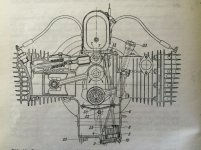Hi there,
I need 4 (four) custom lifters made for a 1930s motorcycle I'm restoring. More is fine for cost benefits. The two I have are badly pitted and in rough shape and I need two more. I can provide a drawing if needed of overall dimensions as well as the samples I have, one full and one cut open. I'm not sure how they were originally made but they appear to have been casted, ground and then hardened. At least that's what the internal geometry leads me to believe. Otherwise, the cam surface has been welded on and then obviously the whole lifter finished-machined and hardened? The lifter is hollow with a wall thickness of 2mm all around. The outside diameter is 25mm. I have new adjustment screws so I just need the body.
Anyways, I don't know anything about lifter technology and so I was wondering if these can be made alternatively by just machining and then hardening. I don't know how weight affects performance or operation so I'm not sure how to proceed but my alternative thought to casting is to just drill out the center to the hole tap size leaving a slightly heavier lifter.
I included some pics. Thanks for any help


I need 4 (four) custom lifters made for a 1930s motorcycle I'm restoring. More is fine for cost benefits. The two I have are badly pitted and in rough shape and I need two more. I can provide a drawing if needed of overall dimensions as well as the samples I have, one full and one cut open. I'm not sure how they were originally made but they appear to have been casted, ground and then hardened. At least that's what the internal geometry leads me to believe. Otherwise, the cam surface has been welded on and then obviously the whole lifter finished-machined and hardened? The lifter is hollow with a wall thickness of 2mm all around. The outside diameter is 25mm. I have new adjustment screws so I just need the body.
Anyways, I don't know anything about lifter technology and so I was wondering if these can be made alternatively by just machining and then hardening. I don't know how weight affects performance or operation so I'm not sure how to proceed but my alternative thought to casting is to just drill out the center to the hole tap size leaving a slightly heavier lifter.
I included some pics. Thanks for any help



